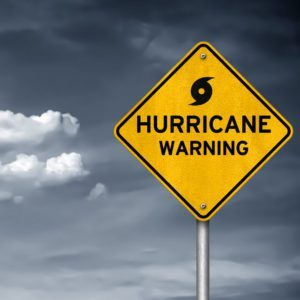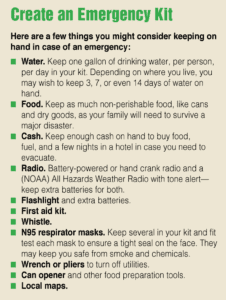By Adrian Karver, Regional Safety Manager
 As we move into fall, we start to think about cooler weather, holidays, and gathering with family. The last thing we want to think about is preparing for potential natural disasters such as wildfires, floods, hurricanes, earthquakes, or tornadoes. We hope that no one reading this ever has to endure such an event, but we operate under the “better safe than sorry” principle and wanted to take this opportunity to encourage you and your family to take these simple steps now to prepare for any future emergency. While safety needs to be a big part of our focus in our industry, it certainly doesn’t end with our workday, as we want our employees and customers to be well prepared and safe in all areas of their life.
As we move into fall, we start to think about cooler weather, holidays, and gathering with family. The last thing we want to think about is preparing for potential natural disasters such as wildfires, floods, hurricanes, earthquakes, or tornadoes. We hope that no one reading this ever has to endure such an event, but we operate under the “better safe than sorry” principle and wanted to take this opportunity to encourage you and your family to take these simple steps now to prepare for any future emergency. While safety needs to be a big part of our focus in our industry, it certainly doesn’t end with our workday, as we want our employees and customers to be well prepared and safe in all areas of their life.
 Taking simple actions to protect against potential disasters can help keep your family safe, limit property damage and repair costs, and allow you to help support your community. To prepare yourself and your family for a disaster, we encourage you to take the following steps:
Taking simple actions to protect against potential disasters can help keep your family safe, limit property damage and repair costs, and allow you to help support your community. To prepare yourself and your family for a disaster, we encourage you to take the following steps:
- Know your risks: Visit your state and local government’s emergency management websites to look for more information about the common types of disasters and whether disaster plans exist for your area.
- Keep informed with alerts and warnings: There are many alert and warning systems to keep you and your family up to date while at work, home, school, or away. Learn which are available in areas where you spend a lot of time and subscribe to them.
- Create a family emergency communication plan: Know how to contact and meet family members before, during, or after a disaster.
- Make an evacuation and shelter plan: You must find protection for you and your family when disaster strikes. Deciding whether to evacuate or to shelter in place depends on many factors, including the hazard you are facing and whether your shelter will keep you safe.
 Gather emergency supplies: Gathering an emergency supply kit is an essential component to disaster preparedness. You should store emergency supplies in different places, such as your home, office, and vehicle.
Gather emergency supplies: Gathering an emergency supply kit is an essential component to disaster preparedness. You should store emergency supplies in different places, such as your home, office, and vehicle.- Prepare your critical documents: It is important to find and gather your valuables and critical information that will help you recover quickly and effectively after a disaster (i.e. birth certificates, living wills, passports, insurance documents, medical records, etc.) Consider keeping these documents in a fire-proof safe in a central location in your home and storing copies of these digitally or at another location
- Understand your policy: The insurance industry identifies a cause of loss, such as fire or theft, as a “peril.” Insurance only applies when your policy covers the peril that caused the loss. Check your policy to see which perils it covers, and in what situations, as well as what the deductibles would be. In general, according to the Insurance Information Institute, homeowners’ insurance policies cover the following potential perils:
- Civil unrest
- Explosions
- Falling objects
- Fires/Wildfires
- Hail
- Hurricanes (but not flooding)
- Malfunctioning plumbing, air conditioning, heating, and sprinkler systems
- Theft
- Tornadoes (but not flooding)
- Vehicular damage
- Volcanoes
- Understand your flood risk: Flooding is the most common and costly disaster in the U.S. Talk with your insurance agent to see if your property is at risk for flooding or mudflows, including those caused by hurricanes or earthquakes, to consider adding flood insurance to your plan.
- Document your property: Keep a detailed record of your valuable belongings to help you recover and file a claim more quickly. Walk through your home and make a video or take pictures of everything you see, then work from that (and don’t forget to open closets and drawers!). Remember that you may be able to get tax credits or deductions for your losses, but documentation is important.
- Protect your property: There are actions that you can take right now that can mitigate the impact that a potential disaster might have on your home or property, such as trimming trees away from your home, installing working shutters, anchoring your manufactured home, or creating a tornado-safe room to protect your family.
- Practice your disaster plans: Make a schedule to practice, update, and tailor your plans. Take the following actions regularly:
- Test your evacuation and shelter plan
- Test your communication plan
- Refresh your emergency supplies (at least every six months)
- Hold an emergency response drill
- Keep your critical documents safe and updated
- Review your inventory (update as your belongings change)
- Have an insurance checkup
- Take part in your community: You can help support your community before, during, and after a disaster. Contact your local emergency manager to learn about opportunities near you. Nonprofits, faith-based organizations, schools, and civic groups are all great places to begin your search.
No one wants to spend time planning for a disaster, but the consequences of not being prepared can be far worse than the time and effort to prepare ahead of time. More detailed information, links, lists and recommendations to help you be prepared for a disaster can be found at www.ready.gov/plan, and at www.redcross.org/get-help/how-to-prepare-for-emergencies.html. Stay safe out there!
 Gather emergency supplies: Gathering an emergency supply kit is an essential component to disaster preparedness. You should store emergency supplies in different places, such as your home, office, and vehicle.
Gather emergency supplies: Gathering an emergency supply kit is an essential component to disaster preparedness. You should store emergency supplies in different places, such as your home, office, and vehicle.